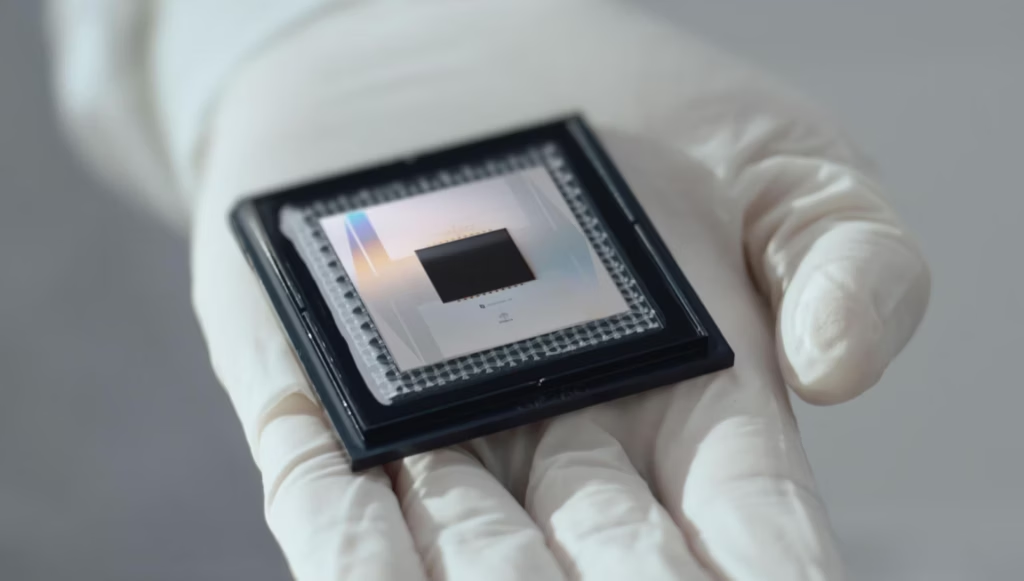Table of Contents
- What Is Google’s Willow Quantum Chip?
- How Does Bitcoin’s Encryption Work?
- Can Willow Hack Bitcoin Now?
- The Real Threat: Future Quantum Advancements
- What Is Being Done to Protect Crypto from Quantum Computing?
- Investor Takeaway: Should You Be Concerned?
The future of cryptocurrency security just got a lot more interesting — and a bit more nerve-wracking — thanks to Google’s latest quantum computing breakthrough. The unveiling of their Willow quantum chip has stirred debates about the future of Bitcoin and its encryption methods. Could Googles’ new quantum chip crack Bitcoin’s encryption soon? Let’s dive into the facts, fears, and forecasts shaping this critical conversation before you buy Bitcoin.
What Is Google’s Willow Quantum Chip?
Google’s new quantum chip, called Willow, represents a major leap forward in computing power. Unlike traditional computers that process one calculation at a time, quantum computers use “qubits” that can exist in multiple states simultaneously. Willow features 105 qubits and can perform in five minutes what would take today’s most advanced classical supercomputers 10 septillion years to complete.
Even more impressive, Google solved one of the biggest challenges in quantum computing: reducing error rates as the number of qubits increases. This technological feat positions Google at the forefront of the quantum race, and while it’s a landmark achievement, the implications for crypto security are both exciting and unnerving.
How Does Bitcoin’s Encryption Work?
To understand why Google’s chip matters, it’s important to know how Bitcoin’s security operates. Bitcoin relies on two key cryptographic algorithms:
Advertisement
Join Gemini today and get $15 in free Bitcoin when you trade with an easy, secure and U.S.-regulated crypto exchange you can trust. Offer valid for U.S. residents only; crypto investments are risky.
- SHA-256 (for mining and block hashing)
- ECDSA (Elliptic Curve Digital Signature Algorithm, for securing wallet keys)
These encryption methods are robust, but they weren’t designed with quantum computing in mind. Traditional computers would need an unimaginable amount of time to break these algorithms. However, quantum computers, using the principles of quantum mechanics, can work exponentially faster on certain problems, such as factoring large numbers — which is fundamental to breaking cryptographic keys.
Can Willow Hack Bitcoin Now?
Short answer: No.
While Willow’s computational power is jaw-dropping, it’s far from capable of cracking Bitcoin’s encryption. Experts say it would take a quantum computer with millions of qubits to pose a legitimate threat to Bitcoin’s SHA-256 and ECDSA encryption methods. Willow, with only 105 qubits, is not even close to this threshold.
For context, Chris Osborn, a crypto security expert, explained that breaking modern encryption requires around 5,000 logical qubits, which corresponds to millions of physical qubits. The difference is vast, like comparing a paper airplane to a space shuttle. While Willow is impressive, it’s still an experimental research tool, not a Bitcoin-cracking monster.
The Real Threat: Future Quantum Advancements
The big concern isn’t Willow itself but the next generations of quantum computers. The development of error-correcting qubits and larger, more stable quantum systems could eventually make crypto encryption vulnerable.
Experts predict that quantum threats to crypto may become real between 2030 and 2050. If a future quantum computer reaches the “million qubit” milestone, it could theoretically decrypt Bitcoin wallets and blockchain signatures. This has led some to speculate that early Bitcoin wallets using Pay-to-Public-Key (P2PK) addresses — including those of Bitcoin creator Satoshi Nakamoto — may be at risk if quantum attacks become possible.
What Is Being Done to Protect Crypto from Quantum Computing?
The crypto industry isn’t sitting idle. Here’s what’s being done to future-proof Bitcoin and other cryptocurrencies:
- Quantum-Resistant Algorithms
Projects like Ethereum are exploring post-quantum cryptographic methods. These methods aim to replace SHA-256 and ECDSA with quantum-resistant alternatives, ensuring future blockchains remain secure even if quantum computing becomes powerful enough to break current encryption. - Quantum-Safe Wallets
Wallet developers are working on quantum-safe wallets that use post-quantum cryptographic keys. Instead of traditional ECDSA signatures, these wallets would use “hash-based” or “lattice-based” cryptography, which is harder for quantum computers to crack. - Gradual Upgrades
Some blockchain developers propose gradually upgrading Bitcoin’s protocols over the next two decades. Satoshi Nakamoto himself hinted that Bitcoin could evolve to use stronger cryptographic algorithms if needed. This built-in flexibility means that even if quantum computers become a threat, the network could migrate to quantum-safe algorithms.

Investor Takeaway: Should You Be Concerned?
So, should crypto investors be worried about Google’s new quantum chip? Not immediately. While the Willow chip is a technological marvel, it’s not powerful enough to crack Bitcoin or other crypto assets today. The consensus among experts is that true quantum threats won’t arrive until 2030-2050.
However, that doesn’t mean you should be complacent. The crypto world is already taking steps to prepare for a quantum future. Quantum-resistant algorithms, quantum-safe wallets, and gradual blockchain upgrades are all part of the strategy.
What should investors do?
- Stay informed: Follow updates on quantum computing and crypto security developments.
- Diversify: Consider diversifying your crypto portfolio, as not all coins will be affected equally.
- Adopt secure practices: Use hardware wallets with high-security standards and avoid leaving large sums on exchanges.
The introduction of Google’s Willow chip is a reminder that technological advances can disrupt even the most secure systems. But for now, Bitcoin’s cryptographic defenses remain strong.



